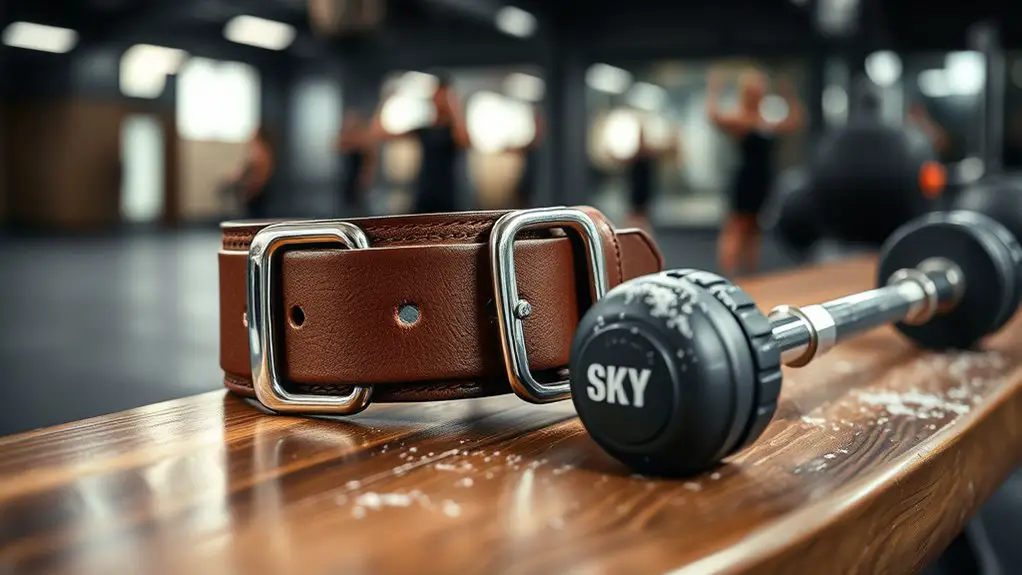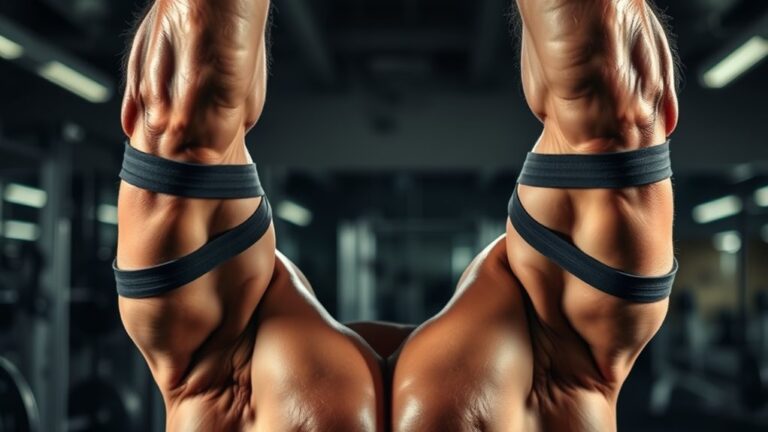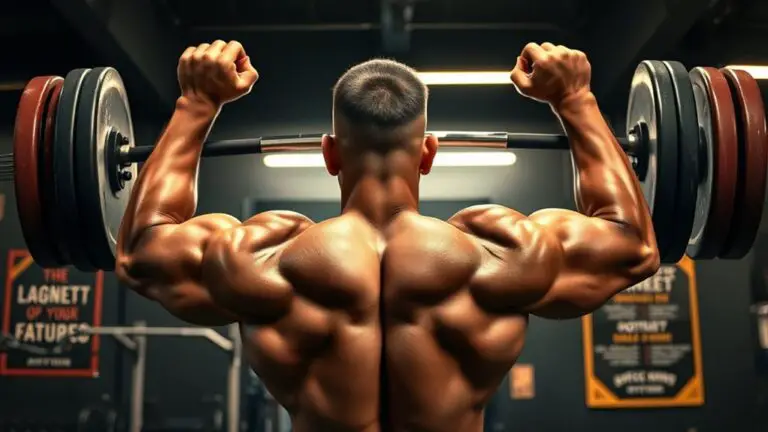Are Weightlifting Belts Necessary?

Weightlifting belts aren’t absolutely necessary, but they can greatly enhance your lifting safety and performance, especially during heavy lifts. They provide core support, stabilize your spine, and help prevent injuries. However, over-relying on a belt may weaken your core muscles. If you lift heavy weights, using a belt can be beneficial, but balance is key. Want to know more about when and how to effectively use a weightlifting belt? There’s more to discover!
Understanding Weightlifting Belts

When you’re diving into the world of weightlifting, understanding weightlifting belts can greatly enhance your performance and safety. A well-designed belt provides support, helping to stabilize your core during heavy lifts. The belt construction is essential—it typically features a thicker back to provide maximum support and a tapered front for comfort.
You’ll find belts made from various materials, including leather, nylon, and suede. Leather belts are known for their durability and support, while nylon belts are often lighter and more flexible, making them suitable for dynamic movements. Each material has its benefits, so it’s important to choose one that aligns with your lifting goals and comfort.
When selecting a weightlifting belt, pay attention to the fit as well; it should be snug but not restrictive. Understanding these elements will help you make an informed decision, ensuring you prioritize safety while maximizing your lifting potential.
Benefits of Using a Weightlifting Belt
Using a weightlifting belt can greatly enhance your lifting experience, as it provides essential support for your core during heavy lifts. This added support helps stabilize your spine, allowing you to maintain proper form and technique. When you’re lifting heavy weights, the effectiveness of a belt becomes clear; it increases intra-abdominal pressure, which can help you lift more safely and effectively.
Moreover, wearing a belt can considerably contribute to injury prevention. By reinforcing your core, it reduces the risk of strains and injuries, particularly in your lower back. This is especially important when you’re pushing your limits or trying new personal records.
Ultimately, a weightlifting belt can be a valuable tool for anyone serious about strength training. It not only boosts performance but also prioritizes your safety, allowing you to focus on your lifts with confidence.
Potential Drawbacks of Weightlifting Belts

While weightlifting belts can provide support, relying too heavily on them might weaken your core engagement. If you depend on the belt too much, you could risk injury when lifting without it. It’s important to weigh these potential drawbacks against the benefits as you consider using a belt.
Over-Reliance on Support
Although weightlifting belts can provide valuable support during heavy lifts, relying too heavily on them can lead to a decline in your core strength. This support dependency might make you feel secure, but it can prevent you from developing the necessary muscle stability. When you become accustomed to the belt, your body may not engage the core muscles effectively, hindering strength maintenance over time. If you depend on a belt for every lift, you risk compromising your overall performance and safety. It’s crucial to strike a balance—use the belt when needed, but also work on building your core strength without it. This approach guarantees you’re not only lifting safely but also enhancing your strength for the long term.
Limited Core Engagement
When a weightlifting belt is worn too frequently, it can greatly limit your core engagement during lifts. This reduced engagement may hinder your core stability, leading to less muscle activation in your abdomen and lower back. Over time, this can negatively affect your overall strength and performance.
Here’s a quick comparison of core engagement with and without a belt:
| Condition | Core Stability | Muscle Activation |
|---|---|---|
| Without Belt | High | Ideal |
| With Belt | Moderate | Reduced |
| Rarely Using Belt | High | Ideal |
| Frequently Using Belt | Low | Diminished |
To guarantee you maintain proper strength development and safety, consider balancing your belt usage with core-focused training.
Potential Injury Risk
Using a weightlifting belt can sometimes give a false sense of security, leading you to push your limits without considering proper form and technique. While a belt provides biomechanical support, it shouldn’t replace your focus on injury prevention. If you rely too heavily on a belt, you might neglect developing your core strength, which is vital for overall stability and safety during lifts. This over-reliance can increase the risk of injuries when you attempt lifts without the belt. It’s important to remember that a belt is a tool, not a crutch. Always prioritize maintaining good form and gradually increasing weights while listening to your body. Balancing belt use with core engagement can help guarantee you’re lifting safely and effectively.
When to Use a Weightlifting Belt

Knowing when to use a weightlifting belt can greatly impact your performance and safety in the gym. A belt can enhance your core stability, especially during heavy lifts. It’s essential to use it in specific situations to maximize benefits while maintaining proper weightlifting technique.
| Situation | When to Use a Belt | Benefits |
|---|---|---|
| Heavy Lifts | Squats, deadlifts over 80% of your max | Provides support, reduces injury risk |
| Compound Movements | Olympic lifts, bench press | Enhances core engagement and stability |
| Fatigue Setting In | Last few reps of a challenging set | Helps maintain form and technique |
| Beginner to Intermediate | Learning proper technique in heavy lifts | Offers confidence and safety |
| Injury Recovery | Returning from back injuries | Supports recovery while lifting safely |
Using a belt wisely can aid in your progress while keeping your body safe.
Types of Weightlifting Belts
Choosing the right weightlifting belt can further enhance your lifting experience. There are several types to evaluate, each designed for specific needs and safety. Leather belts are popular for their durability and support, making them ideal for heavy lifts in powerlifting. Neoprene belts, on the other hand, offer flexibility and comfort, perfect for lighter weights or bodybuilding routines.
If you’re into powerlifting, look for powerlifting belts that are wider and thicker for maximum stability. Olympic belts are typically thinner, catering to the dynamic movements of Olympic lifts. Adjustable belts provide versatility as they can easily be tightened or loosened, ensuring a snug fit while you lift.
Ultimately, selecting the right belt depends on your lifting style and personal comfort. Prioritizing safety is key, so choose a belt that meets your specific needs and helps you lift with confidence.
How to Properly Wear a Weightlifting Belt
A properly worn weightlifting belt can considerably enhance your stability and support during lifts. To guarantee you’re using it effectively, focus on achieving a proper fit and mastering adjustment techniques.
| Step | Description |
|---|---|
| Position the Belt | Place the belt around your waist, just above your hip bones. |
| Tighten the Belt | Pull the belt snug, guaranteeing it’s tight enough to support but not restrict your breathing. |
| Secure the Closure | Fasten the buckle or Velcro, guaranteeing it stays secure throughout your lift. |
Making the Decision: To Belt or Not to Belt
When considering whether to use a weightlifting belt, you should weigh the benefits against the risks of lifting without one. A belt can provide essential support for your core, but going without it might help you develop stability and strength naturally. Ultimately, it’s about finding what works best for your body and training goals.
Benefits of Using Belts
While some may debate the necessity of weightlifting belts, their benefits can be significant for many lifters. A well-constructed belt, made from durable belt materials, can provide essential support to your core during heavy lifts. This added stability helps you maintain proper lifting techniques, reducing the risk of injury. By increasing intra-abdominal pressure, a belt allows you to lift heavier weights safely, making it easier to push your limits. Additionally, using a belt can enhance your confidence when tackling challenging lifts. For those focused on safety and performance, investing in a quality weightlifting belt might be a smart choice. Remember, the right belt can be a valuable tool in your strength training arsenal, helping you achieve your fitness goals.
Risks of No Belt
Choosing to forgo a weightlifting belt can expose you to several risks, especially during heavy lifts. Without a belt, you may compromise your core stability, which is critical for maintaining proper form under heavy loads. This lack of support can lead to poor lifting mechanics, increasing your chances of injury. When your core isn’t adequately stabilized, the strain on your back and other muscles intensifies, heightening the risk of acute injuries or chronic pain. Prioritizing injury prevention is fundamental for anyone serious about weightlifting. While some lifters feel confident without a belt, it’s essential to evaluate whether you’re fully prepared to handle the demands of heavy lifting safely. Ultimately, using a belt can provide that extra layer of support when you really need it.
Frequently Asked Questions
Can Beginners Use Weightlifting Belts Effectively?
Yes, beginners can use weightlifting belts effectively, but it’s essential to prioritize proper technique first. A belt can aid in injury prevention by providing additional support to your core during heavy lifts. However, relying solely on a belt might hinder your ability to develop core strength. It’s best to use one once you’re comfortable with your form and lifting technique, ensuring you’re building a solid foundation for safe and effective workouts.
How Do I Choose the Right Size Belt?
When you picture yourself lifting, a well-fitted belt envelops your waist like a supportive hug, enhancing your performance. To choose the right size, measure your waist at the navel and refer to the manufacturer’s sizing chart. Remember, belt materials vary; leather offers durability, while nylon provides flexibility. Ensuring the right fit not only boosts your confidence but also enhances safety during those heavy lifts, keeping your core stable and secure.
Do Weightlifting Belts Expire or Wear Out?
Yes, weightlifting belts can wear out over time. It’s important to regularly check your belt for signs of wear, like fraying or cracking. Proper belt maintenance can extend its life, but if you notice significant damage, it’s best to replace it for your safety. Following safety guidelines is essential; a worn-out belt won’t provide the support you need during heavy lifts. Always prioritize your safety by ensuring your equipment is in good condition.
Are There Any Specific Exercises Where Belts Are Unnecessary?
When it comes to lifting, think of your body as a finely-tuned machine. For bodyweight exercises like push-ups or squats, belts aren’t just unnecessary; they can feel like an anchor instead of a support. In functional training, where balance and core strength shine, you’ll find that your body’s natural stability serves you well. Embracing these exercises without a belt can enhance your safety and help you build strength organically, like a tree growing deep roots.
Can Wearing a Belt Lead to Dependency in Lifting?
Wearing a belt can lead to dependency in lifting if you rely on it too much. While belt usage can enhance stability and support your lifting technique, it’s important not to use it as a crutch. Over time, you might find it hard to lift without it, weakening your core. To stay safe, balance your training by occasionally lifting without a belt to strengthen your core and maintain good lifting habits.





